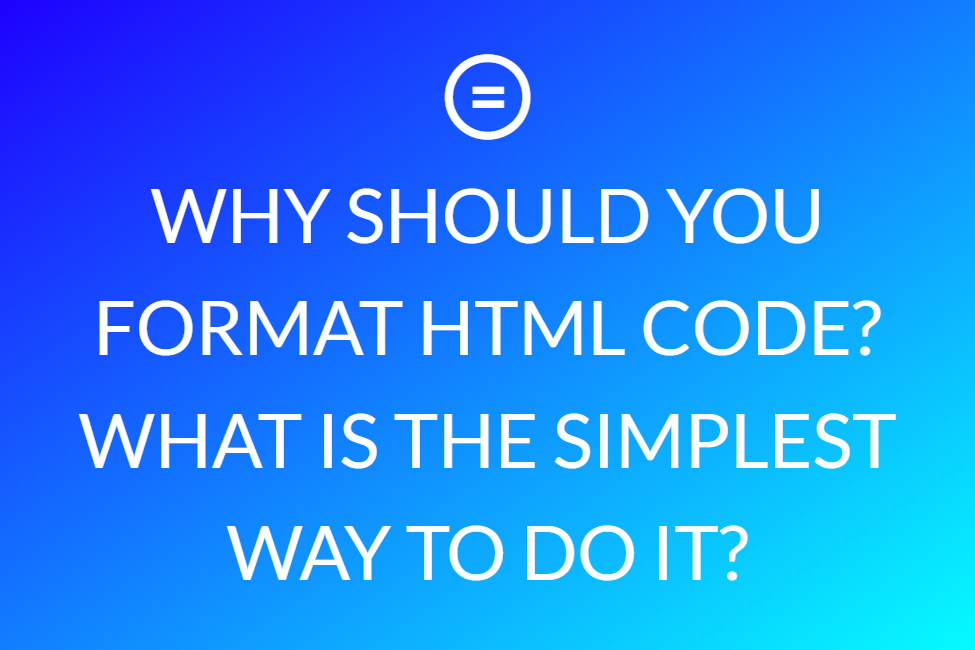What is Minification?
Minification means minimizing code (HTML, JS, CSS, ) and an expansion in the web pages and data. This diminishes loading times and bandwidth extent on websites. Furthermore, its extent site speed and convenience. Also, a user can have ease of access to the website even with a restricted data plan. Daily files include areas to secure the code and make it readable.
Thus, Minification is a method to reduce the data size of the websites with the purpose of accelerating up the load time. It eliminates whitespace and additional characters from the HTML, Javascript code and CSS (the files sent to the visitor’s browsers). This involves removing unwanted line-breaks, code like comments, and also reducing variables and operating names.
Why Minify the HTML?
The primary purpose is to remove excess or unnecessary data, such as extra spacing, well-termed variables, and some of the comments. Although makers tend to produce the code and increase it more readable for those who might operate it later. But it sets a negative impact when it gets to toiling pages. Hence, anything that executes the HTML to make it more readable for the developers but is not required for the accumulation can be changed and eliminated.
When files become minified, comments, variables and extra spaces are removed; and thus the names are crunched to reduce the code and decrease the file size. There is just one downside of this means that the minified data is not clear. So, it is important to keep both accounts in the file. Creators and developers can operate on the person-readable file, although the other variant is used to extend to the server.
HTML, unlike another file, is often executed gzipped. This indicates that when users fetch files, that HTML pages are shown that will be presented related to zip files and removed besides downloading the whole page. The action of gzipping HTML condenses a number of the whitespaces, which are one of the single reasons one would really minify HTML, to work with.
What is this term all about– JavaScript Minification?
Minimization, also described minimization, is the means of removing all extraneous characters from JavaScript reference code without changing their functionality. This involves using modest variable names and tasks to remove blank spaces, comments and explanations. Short file extension as a consequence of minifying JavaScript code.
Minifying is diverse from compression. The data are not condensed, so they don’t ought to be uncompressed through the user’s browser. Rather, they operate as they live with no problems.
The method seems like this:
- A page or column is created
- Files of the surface or post-stay minified
- A visitor’s browser inquires files to showcase the page
- Minified files are transferred to the seeking browser
- Minified files, then thus display within the browser
Benefits of minification include:
- Fewer additional files to recover and download shows the website shall load faster
- Fewer data are transmitted across the network decreases bandwidth price
- The minified expense can be reutilized, so it just needs to stand minified only at once that reducing resource usage
- Files do not require to be uncompressed before using
- More high-speed loading progresses the rate of UX and SEO
We oftentimes hear about the advantages, but we seldom hear about the obstacles. There are times when the process of minification can wreak the website.
How to Minify the Files without even Breaking the Website
There are many reasons why minification might not work. the Websites have a number of components, for example, content, theme, plugins, and even the server. Each of those is different, suggesting that minification with not routinely work for each website all the time. due to this, minification needs trial and error.
Here are some tips for minifying the files without disrupting the website:
- Regularly backup the website before performing changes.
- When accepting plugins, don’t use everything at once. Try the attributes one at a moment and test the spot before examining the next characteristic.
- Don’t use several plugins to minify the files.
- When working on tools like PageSpeed Insights, be concerned about implementing anything. For instance, it might not be feasible to eliminate whole render-blocking sources.
- If particular files are creating obstacles with minification, add these files into the ignore list in the plugin’s settings.
Here are some ways one can reliably minify the files.
Manually
You can complete minification manually. Here are several apps to support:
- HTML – HTMLMinifier
- Server – PageSpeed Module
- CSS – CSS Minifier,CSSO, CSSNano,
- Multiple – Refresh-SF, Minify
- JavaScript – UglifyJS, Closure Compiler
How to practice the process of Minifier and let’s review their Features
Minification is the method of reducing unnecessary codes in the script files and the web pages. It decreases loading times and there are plenty of ways, means that could be practised in minifying code data. In this part, we will be revealing those steps in detail, among it, is:
The Manual Minification –
This method is straightforward, it just requires the designer or the programmer to weed out all codes that are neither that significant in the file nor required. Post minifying the codes, it seems shorter, more manageable, and brief yet very hard to read for humans. A machine interprets the codes and provides the same purpose if it becomes minified and if it isn’t, but since we do need the webpage to load quicker, we therefore opt-in for a minified variant. Manually minification is basically related to the process when one eliminates those unneeded breaks, excess whitespace, from the data that contain codes. This is executed without modifying the capacity of the prevailing code.
Minification With Online Tools –
To keep away from deep pressure, and time-engrossing exercises like the manual minification procedure when designing the website, there’s a collection of tools that are specifically designed to better do the needful. The various mack-up language practices a distinctive minifier. This involves:
- CSS Minification -
this is the method of removing undesirable codes from the common code files, to diminish the size of the file. One can use online media like: CSSminifier.com – These tools simply enable users to lessen their codes by just doing the copy and paste activity on the website. The website then presents them in return for a minified account of their file. It is really easy and preserves time one might have killed doing the Manual editing by oneself. Some other online tools provide immediate minification, there are a number of them out there. Feel easy to examine them.
- HTML minification
HTML minification is a means of reducing the volume of HTML files into smaller sizes. This process will certainly enhance the speed of loading and thus will avoid extra used time. You can minify HTML data codes by utilising this tool - HTML minifiers. This is one of the most useful ones known to use and may be adjusted into one’s programme, easily. Another website tool can support minifying the HTML data.
In a short sum-up, to be honest, it is not a missile or a scientific method or a cheating means. It won’t deliver the website a wonderful gain. It is similar to that of the finishing-tune-up stage. One just uses the minification after having successfully addressed the code. It is the final stage of tuning and there will be a small modification in web pages, however, do not require a speed of a low set of speed.




